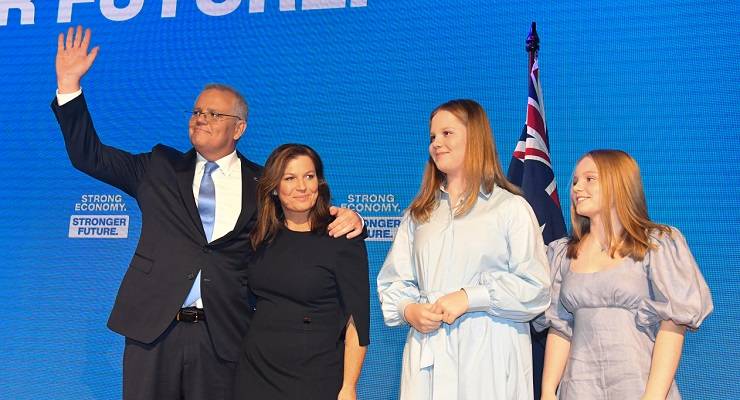
Can a struggling government reverse its fortunes in less than a week? Scott Morrison will be hoping so, but appears in need of a second electoral miracle, with the prime minister addressing a largely unenthusiastic-looking selection of Liberal Party faithful at the campaign launch in Brisbane today.
With the gruelling six-week campaign entering its final stretch, the government has so far been unable to narrow Labor’s lead in all published opinion polls. Internally, party strategists are getting anxious.
The long campaign was meant to wear down Anthony Albanese. But since recovering from his opening day gaffe, the opposition leader has appeared to grow in stature.
Morrison, meanwhile, has undergone a series of remarkable tonal shifts, as he tries to convince the electorate to give him another term. In his near-hour-long speech today, we saw yet more evidence of exactly that.
The prime minister began this campaign straddling a sense of optimism about Australia’s post-pandemic recovery, while warning the country that Labor would put all that at risk. Inflation numbers and an interest rate hike saw that optimism replaced by relentlessly negative scare campaigning on the opposition’s economic and national security credentials.
But today, we saw more of the “New ScoMo” unveiled on Friday, when the PM noted he could be “a bit of a bulldozer” and promised to change if reelected. Focus groups show Morrison is no longer a clear electoral asset — many voters find him intensely unpleasant and dislikeable.
Those “bad vibes” have only been reinforced by the overwhelmingly negative messaging that came from the Coalition during the middle weeks of the campaign. Today’s speech was another attempt to re-characterise the prime minister as both a friendlier leader, and one with actual vision for another term in office.
Morrison unveiled three new policies: allowing first home buyers to access superannuation to enter the property market, incentives for older homeowners downsizing their houses, and some money for a cancer centre.
“I’ve got a big plan,” Morrison said.
“I’m seeking a second term because I’m just warming up!”
He pointed to investments in medicare, hospitals and mental health as further evidence of his government actually having some kind of vision for three more years in office. Much of the rest of the speech was devoted to talking up Australia’s success navigating an uncertain few years, marred by a global pandemic, apocalyptic floods and bushfires, and an economic crisis.
“Despite what we have faced, we have remained true to the promise of Australia. And Australia has prevailed. We have kept, as a … government, the promise of Australia.”
Compared to much of the rest of the world, Australia’s position at this stage of the pandemic is a strong one. We have one of the highest vaccination rates and lowest COVID death rates around. Unemployment is, as the PM pointed out, at historic low levels, and despite very real cost of living pressures, other comparable Western countries are arguably doing it tougher.
But despite the government’s desperation to make that comparison, it still looks like voters could abandon the devil they know next week.
Will ScoMo 2.0 convince them otherwise? Will a controversial housing measure dropped six days out from the election make voters forget three years of policy vacuum?
Even when adopting the pretence of having an agenda, Morrison’s vision for Australia remains strikingly small and unimaginative.
The Australian Dream is to get a job and own a home. Maybe, if you’re ambitious, to start a business. To Morrison, Australians are a fundamentally incurious people, not really interested in anything more than that.
This time next week, we’ll know if most of the country agrees with him.








He sets out a plan for next term! What about the last three years Sco Mo? We have seen you over 3 years and you have lied, deceived and totally corrupted Politics .
God help us if there are enough lemmings following you over the cliff.
Nobody ever lost by underestimating the average punter.
“We have seen you over 3 years and you have lied, deceived and totally corrupted Politics .” That’s his plan for the next three. Continuing on with Gods work.
This from the man who couldn’t foresee, three years ago, that electric vehicles were going to overtake IC engined vehicles by 2030, but wants us now to embrace his 40 year vision of our defence needs and economic future. He’s s joke.
He is a joke??? No, then it would be funny and we might laugh! Morrison is a chronic liar, a hypocrite with no moral compass and no empathy or compassion!! Seriously, how could anyone who has been paying even a bit of attention and is reasonably intelligent vote for him or his corrupt government?????
“I’m seeking a second term because I am just warming up,” Morrison said. “Not my job Morrison” is just warming up!!!!! God help Australia from charlatans and snake oil salesmen such as you.Vote this pathetic government out!
Probability of Miracle 2.0 is $80m multiplied by the gullibility quotient of the average Australian.
“Just warming up” . . . that explains the last three years!